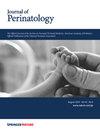Effectiveness of oral dextrose gel for neonates at risk of hypoglycemia: A systematic review, meta-analysis, and GRADE assessment of randomized controlled trials
IF 2.4
3区 医学
Q2 OBSTETRICS & GYNECOLOGY
引用次数: 0
Abstract
Neonatal hypoglycemia is the most common metabolic disorder in newborns and can lead to neurological damage if untreated. While intravenous dextrose is the standard treatment, it is invasive. Oral 40% dextrose gel (0.5 ml/kg) offers a non-invasive alternative. A systematic review of five randomized controlled trials (RCTs), involving 2,742 neonates (1,326 received dextrose gel; 1,416 received placebo), assessed its effectiveness in reducing NICU admissions in neonates with blood glucose < 2.6 mmol/L. Although the overall meta-analysis showed a non-significant reduction in NICU admissions (risk ratio 0.68; 95% CI: 0.33–1.38; p = 0.28), a sensitivity analysis excluding one outlier study improved consistency (I² = 19%) and revealed a statistically significant reduction (risk ratio 0.52; 95% CI: 0.31–0.90; p = 0.02). These findings suggest that oral dextrose gel may reduce NICU admissions in neonates with hypoglycemia, but further large-scale studies are required to confirm its clinical effectiveness.

口服葡萄糖凝胶治疗低血糖风险新生儿的有效性:随机对照试验的系统回顾、荟萃分析和GRADE评估
新生儿低血糖症是新生儿中最常见的代谢紊乱,如果不治疗可导致神经损伤。虽然静脉注射葡萄糖是标准的治疗方法,但它是侵入性的。口服40%葡萄糖凝胶(0.5 ml/kg)是一种非侵入性的替代方法。一项系统回顾了5项随机对照试验(RCTs),涉及2742名新生儿(1326名接受葡萄糖凝胶治疗,1416名接受安慰剂治疗),评估了其降低血糖< 2.6 mmol/L新生儿NICU入院的有效性。虽然整体荟萃分析显示新生儿重症监护病房入院率无显著降低(风险比0.68;95% CI: 0.33-1.38; p = 0.28),但排除一项异常研究的敏感性分析提高了一致性(I²= 19%),并显示统计学上显著降低(风险比0.52;95% CI: 0.31-0.90; p = 0.02)。上述结果提示,口服葡萄糖凝胶可降低低血糖新生儿NICU入院率,但其临床有效性有待进一步的大规模研究证实。
本文章由计算机程序翻译,如有差异,请以英文原文为准。
求助全文
约1分钟内获得全文
求助全文
来源期刊

Journal of Perinatology
医学-妇产科学
CiteScore
5.40
自引率
6.90%
发文量
284
审稿时长
3-8 weeks
期刊介绍:
The Journal of Perinatology provides members of the perinatal/neonatal healthcare team with original information pertinent to improving maternal/fetal and neonatal care. We publish peer-reviewed clinical research articles, state-of-the art reviews, comments, quality improvement reports, and letters to the editor. Articles published in the Journal of Perinatology embrace the full scope of the specialty, including clinical, professional, political, administrative and educational aspects. The Journal also explores legal and ethical issues, neonatal technology and product development.
The Journal’s audience includes all those that participate in perinatal/neonatal care, including, but not limited to neonatologists, perinatologists, perinatal epidemiologists, pediatricians and pediatric subspecialists, surgeons, neonatal and perinatal nurses, respiratory therapists, pharmacists, social workers, dieticians, speech and hearing experts, other allied health professionals, as well as subspecialists who participate in patient care including radiologists, laboratory medicine and pathologists.
 求助内容:
求助内容: 应助结果提醒方式:
应助结果提醒方式:


